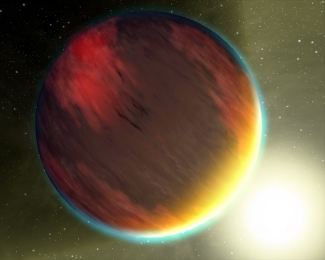Hot Jupiters — giant gas planets orbiting close to their parent stars — aren’t just scorched (at temperatures of >1000 K). They are also swollen up larger than can be explained by the intense heat from their host stars. Recently Fellow Rosalba Perna and her colleagues from Columbia University and the Kavli Institute for Theoretical Physics suggested a reason why these planets are so puffed up: The swelling results from heat dissipated from electric currents generated by the interaction of robust magnetic fields (generated from deep within the giant planets) with strong atmospheric winds carrying charged particles called ions.
Ionization in the winds occurs as a result of the tidal locking of the planets to their parent stars. This tidal locking keeps one side of the planet facing the blistering stellar heat. The heat is intense enough to literally strip electrons from some of the atoms and molecules in the planet’s atmosphere, creating ions that blow in the winds.
When ionized atmospheric winds cross a hot Jupiter’s magnetic field lines, the magnetic lines bend, inducing electric currents that give off enough heat to puff up the planet. Because this heat is produced in the deepest layers of a hot Jupiter’s atmosphere, it can substantially modify the evolutionary path of these planets and account for their large sizes. The amount of heat produced deep in the atmosphere could equal as much as, or even more than, 1% of the heat due to the nearby star, which affects mostly the outermost regions of the planets, according to Perna and her colleagues.
The researchers showed how this process works with a three-dimensional model of the atmospheric circulation of a real hot Jupiter (HD 209458b, the first transiting planet [1] discovered outside the solar system). Their model showed that the dissipation of the electric currents caused by the interaction of HD 209458b’s magnetic field lines with its weakly ionized atmospheric winds could indeed heat up the atmosphere enough to account for the planet’s increased bulk if the planet’s magnetic field strength was at least 10 Gauss (as compared to Earth’s magnetic field strength of 0.5 Gauss at its surface).
This calculated magnetic field strength for a hot Jupiter falls in the middle of the range of magnetic field strengths (4.2–14 Gauss) measured for the planet Jupiter in our own solar system. However, it is still difficult to determine the magnetic field strengths for planets outside the solar system, both observationally and theoretically. While observations of hot Jupiters continue, Perna and her collaborators are also enhancing their atmospheric circulation model with winds that consistently incorporate ionization, magnetic drag, and dissipation of electric currents. They are also developing evolutionary planet models that include the newly discovered source of heat. - Julie Phillips
[1] A transiting planet is one that passes in front of its parent star while the star is being observed by an Earth- or space-based telescope.




